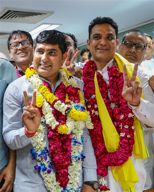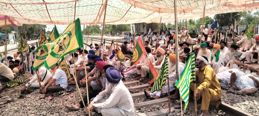Harish Khare
.jpg) “Route laga hai ji.” There is no exact English translation of this expressive declaration, but in police lingo it gets translated into “a super-VIP is to travel this road”. Hence, the decision to close the road to the commoners.
“Route laga hai ji.” There is no exact English translation of this expressive declaration, but in police lingo it gets translated into “a super-VIP is to travel this road”. Hence, the decision to close the road to the commoners.
A few days ago, it was reported that a very large number of passengers on the Chandigarh-Delhi Shatabdi train were put to harassment and inconvenience because the Governor of Punjab had decided to travel on that train. As per the SOP — Standard Operating Procedure, for the uninitiated — the vehicular traffic on the road leading to the railway station was restricted.
In popular imagination and media discourse, this is called the “VVIP culture”. The accusing finger is pointed in the direction of the dignitary. In fact, it is perhaps the security officials and local policemen who tend to get overzealous.
During my PMO days, I was part of the Prime Minister’s motorcade in very many countries and our movement was always facilitated with the minimum of fuss and minimum of inconvenience to the local residents. In most countries, just three or four motorcycle outriders do the “route” job. One of them would expertly block the road just for less than 30 seconds while the other three would take up positions at the following intersections. Turn by turn, they would zoom past the motorcade.
The only time there is inconvenience to citizens is when the United Nations General Assembly meets in New York. The presence of so many heads of state and government does mean considerable disruption in life on the east side of Manhattan. And, the day the American President arrives in town to address the General Assembly, there is, what the Americans call, a total lockdown.
In India, after Indira Gandhi’s assassination and the birth of the Special Protection Group (SPG), a new “blue book” of security was drawn up. The SPG was given extraordinary authority to overrule the local police in matters of arranging the Prime Minister’s security whenever he would visit a city/town outside the National Capital. The DGP is technically answerable for any security lapse. The outcome is the overkill approach. Senior police officers have an inclination to over-saturate, over-deploy, over-bandobastify. Leave nothing to chance. And, if it means inconvenience, harassment, disruptions to the citizens, so be it.
It is this SPG-inspired habit that gets replicated in the states. What the police in the state capitals or a union territory like Chandigarh are not able to do is to impress upon the VVIP dignitary to be punctual. The prime ministers gradually lose their appetite for moving around, because they realise the difficulty it causes to the commuters.
It is not that Kaptan Singh Solanki faces a security threat. He does not get the same treatment in Delhi. In fact, in New Delhi, no one except the President and Prime Minister “gets a route”.
Soon after Advani was named Deputy Prime Minister, his staff thought he should have the same “route” bandobast as the Prime Minister. One day, he was horrified to read in the newspapers that very many students could not reach the examination centre because the Delhi Police had blocked the roads. Thereafter, a repentant Advani drastically curtailed his movement.
Governors are (till they reach a Raj Bhavan) political people and fairly mindful of the people’s reaction. I am pretty sure that Solanki would be horrified to know that his movement around the city caused resentment.
.jpg) A new, racy, absorbing book, Midnight Furies, by Nisid Hajari, refreshes our memory of those deadly days of the months preceding and following the Partition. A historian, Hajari has produced a riveting account of the clash of principles and personalities that led to India’s bloody division.
A new, racy, absorbing book, Midnight Furies, by Nisid Hajari, refreshes our memory of those deadly days of the months preceding and following the Partition. A historian, Hajari has produced a riveting account of the clash of principles and personalities that led to India’s bloody division.
In putting the Nehru-Jinnah standoff at the centre of his narrative, Hajari seems to overemphasise the personality factor. While Jinnah was certainly the sole decision-maker in the Muslim League, Nehru was firmly guided and bound by the Congress Working Committee and its detailed directives. Historians will be historians.
However, in the current revisionist mood, the book is likely to be used to belittle and besmirch Nehru’s reputation.
Hajari’s book draws attention, once again, to Sardar Patel’s flaws. If he had had even one-tenth of the scrutiny that Nehru has had, historians would have had no difficulty in declaring that Patel was not exactly a great success as Home Minister. Historians and other keepers of our collective memory have been kind to him and no one wants to remember — or be reminded of — the troublesome fact that the Mahatma was assassinated in Delhi on Patel’s watch.
There was violence in and around Delhi after August 15, 1947. The air was thick with a certain kind of madness. How that madness was to be dealt with brought into sharp focus differences in approach among leaders. On Patel’s watch, the Delhi Police were less than half-hearted in performing their professional duty of putting down anti-Muslim violence. And, yet, Patel remained zealously protective of the Delhi Police.
On the other hand, according to Hajari’s account, Nehru seemed to believe that he had a better chance of quelling the unrest single-handedly than by working through his administration. He went “on the prowl whenever he could escape from the (cabinet) table, and took appalling personal risks”.
Mountbatten feared Nehru’s impulsiveness would get him killed and assigned soldiers to watch over him.
Hajari’s book is more useful for reminding us how India and Pakistan remain imprisoned in, what he calls, “the deadly legacy of India’s Partition”.
“Now no less than in 1947, India does not gain from Pakistan’s internal difficulties. Having a weak, unstable state on its border distracts strategic attention in Delhi and drains resources that could be better invested elsewhere. The conflict prevents India from playing the leadership role in Asia that Nehru and others hoped for after Independence and weakens its global clout. Kashmir remains a cauldron of discontent — and not just because of Pakistani meddling.”
Sane thoughts. But who is listening? Certainly, not our new strategic warriors.
 ON Friday evening, I got a communication from a Mohali-based reader, Paras Kalotra. He wanted to know my reaction to the horrific news from Moga that six persons, including a granthi, had lost their lives in some kind of tantric ceremony. This relapse into medieval occult did not square with “a modern religion like Sikhism”.
ON Friday evening, I got a communication from a Mohali-based reader, Paras Kalotra. He wanted to know my reaction to the horrific news from Moga that six persons, including a granthi, had lost their lives in some kind of tantric ceremony. This relapse into medieval occult did not square with “a modern religion like Sikhism”.
This dispatch took me back to an old conversation. Many years ago, in my mother-in-law’s library, I found a book titled Death of a Witch, written by GM Carstairs, a Scottish anthropologist. He was a friend of my in-laws. The book was about his 30 long years of field work at a village in Rajasthan.
A few years later, Professor Carstairs happened to be in Delhi and I remember asking him about the eye-catching title. He explained that as an anthropologist, he was interested in knowing how “backward” societies dealt with death or illness. The modern society has access to medical science and its professional practitioners. In backward societies, people seek the advice of shamans and exorcists in coping with adversity. In contrast, the modern society subscribes to a “scientific temper” and seeks a “rational” explanation of a baffling or inexplicable event.
Professor Carstairs recalled that in this Rajasthan village, named Sujarpura, the villagers had thrashed a widow to death because she was suspected by them to be the cause of many deaths, especially of children. While the local-level official did empathise with the villagers and their belief system, he also felt obliged to uphold the (modern) law and, consequently, insisted on meting out punishment to the gang-leaders.
I am sure if Professor Carstairs were still alive today (he died a few years ago), he would have had a nuanced explanation for the Moga deaths. Despite all the progress we have made, islands of ignorance and irrationality still abound in various parts of our country. A few days ago, it was reported that a woman was hacked to death in Odisha because she was suspected — guess what — of being a witch!
Back to Paras Kalotra: “Sir, orthodoxy and ritual culture have diminished completely the fair face of our Gurus and Gurbani. The caste system is still prevalent in Sikhism. The culture of rituals has still not been done away with.” I am inclined to share Paras’ lament as to why the Sikh religious leadership, including the SGPC, is not able to exercise a “modern” influence over its own priesthood.
The same lament can also be directed at other religions. Unfortunately, over the last three decades, particularly since the days of the Ayodhya movement, India has become more and more ritualistic. Our religion-based divisive politics has even enlisted the younger generation in its unenlightened ritualistic orthodoxy.
My own conviction is that if India has to find its national destiny, we will need to rediscover the Nehruvian notion of “scientific temper”.
ON Thursday, I was in Srinagar. I was visiting the city after a gap of seven years and was flabbergasted at the proliferation of cars. Traffic moved slowly. The city now has that ugly ubiquitous urban phenomenon: a flyover. Another one is under construction so that the motorists could be spared of traffic jams.
The vehicular population, multiplied many times over, is a reflection of the changed Kashmir. The shops are loaded with all sorts of consumer goods. Shopping malls have come up. Because it happened to be days before Eid, there was that extra flurry of buying activity.
In the evening, the boulevard, near the Dalgate, was full of tourists. The place looked more like Karol Bagh in Delhi.
.jpg)
The landscape has certainly changed. However, I had a feeling that this air of transformation was somewhat deceptive. In fact, I did not sense any qualitative change in the mindscape. The vocabulary of resentment has not been abandoned. Too many people and too many forces, inside and outside the Valley, have a stake in grievance-mongering.
Care for coffee?
[email protected]



























